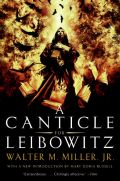 A Canticle for Leibowitz by Walter Miller technically fits into the science fiction genre and the post-apocalyptic sub-genre, but at the same time it’s different from other books that might share those classifications. The closest thing to a a main character that spans the book’s considerable timeline is actually a monastery in the blasted remains of the Southwestern United States. The monastery’s order is dedicated to Saint Leibowitz, an electrical engineer who helped establish an movement dedicated to preserving scientific and cultural knowledge in the wake of a cataclysmic nuclear war. Actually, while the nuclear armageddon was bad, the real impediment to civilization’s survival came in the form of “The Simplification” which was a world-wide backlash against all scientific learning that had led to nuclear weapons. Books were burned, knowledge was willfully destroyed, and pretty much anyone who could even read was put to death. Leibowitz, who engaged in “booklegging” in an attempt to preserve human knowledge, was martyred by the “Simpletons” and inspired the same goal in the residents of the monastery featured in each of the book’s three sections.
A Canticle for Leibowitz by Walter Miller technically fits into the science fiction genre and the post-apocalyptic sub-genre, but at the same time it’s different from other books that might share those classifications. The closest thing to a a main character that spans the book’s considerable timeline is actually a monastery in the blasted remains of the Southwestern United States. The monastery’s order is dedicated to Saint Leibowitz, an electrical engineer who helped establish an movement dedicated to preserving scientific and cultural knowledge in the wake of a cataclysmic nuclear war. Actually, while the nuclear armageddon was bad, the real impediment to civilization’s survival came in the form of “The Simplification” which was a world-wide backlash against all scientific learning that had led to nuclear weapons. Books were burned, knowledge was willfully destroyed, and pretty much anyone who could even read was put to death. Leibowitz, who engaged in “booklegging” in an attempt to preserve human knowledge, was martyred by the “Simpletons” and inspired the same goal in the residents of the monastery featured in each of the book’s three sections.
Interestingly, the monastery’s story spans thousands of years and several casts of characters. Things start off many years after the nuclear war when a young novice discovers holy relics of the not-quite-yet-canonized Leibowitz, including a shopping list and an impenetrable electrical diagram. This is during a new dark age possessed of only primitive technology and ruled by barbaric power mongers. Eventually civilization and scientific knowledge begin to knit themselves back together with the help of a few brilliant minds and the materials saved by monks in charge of Leibowitz’s legacy. By the end of the book it’s thousands of years later and mankind has once again employed science and technology to bring comfort and civilization, but it has also proven unable to resist reasserting its mastery over the atom in the form of nuclear weapons. Fearing the worst, a group of Leibowitz’s followers prepare to depart for the stars in order to escape history’s vicious cycle.
In a classic science fiction manner, Miller plays a lot with this theme of civilization’s self-destruction and rebirth, and it seems pretty clearly to be the central point to the book along with the evolving tension between science and religion. In the beginning the Catholic residents of the monastery work to preserve and eventually redevelop scientific knowledge, but over time a tension develops between religious faith and secular progress through science, culminating in a heated and complicated debate between the Order’s abbot and a doctor about how to best deal with human suffering in the victims of terminal radiation poisoning. These kinds of themes are played with on several levels.
It’s fascinating stuff, even if Miller’s style is a bit sterile in spots. And while the book lacks the traditional structure of a novel (it’s more like three related novellas, really) this is one of the reasons why I liked it. It’s different, yet retains that same great science fiction focus on big ideas and fundamental questions about human nature.
It’s such a shame that Miller was a one-hit wonder; clearly, he thought it a shame, too, having killed himself over his inability to write a sequel worth reading.
Canticle is one of those canonical science fiction works that it’s so difficult to ignore; it’s prescient (remarkably so, despite our having not succumbed to nuclear disaster), engaging, and timeless despite being written in an era that usually ages quickly.